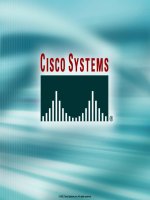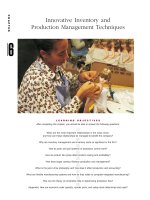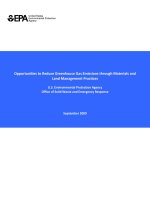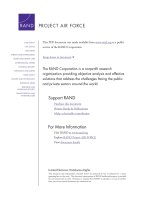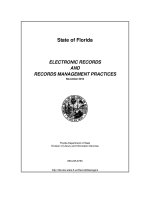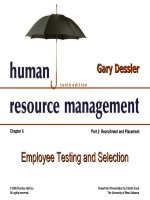Dessler HRM 12e ch 010 coaching careers and talent management
Bạn đang xem bản rút gọn của tài liệu. Xem và tải ngay bản đầy đủ của tài liệu tại đây (1.37 MB, 47 trang )
Chapter 10
Coaching, Careers,
and Talent
Management
Part Three | Training and Development
Copyright © 2011 Pearson Education, Inc.
publishing as Prentice Hall
PowerPoint Presentation by Charlie Cook
The University of West Alabama
WHERE WE ARE NOW…
Copyright © 2011 Pearson Education, Inc. publishing as Prentice Hall
10–2
LEARNING OUTCOMES
1. Compare and contrast coaching and mentoring and
describe the importance of each.
2. Compare employers’ traditional and career planningoriented HR focuses.
3. Explain the employee’s, manager’s, and employer’s
career development roles.
4. Describe the issues to consider when making promotion
decisions.
5. List and briefly explain at least four methods for better
managing retirements.
6. Define talent management and give an example of an
actual talent management system.
Copyright © 2011 Pearson Education, Inc. publishing as Prentice Hall
10–3
Coaching and Mentoring
• Coaching
Involves educating, instructing, and training subordinates
Focuses on teaching shorter-term job-related skills
• Mentoring
Is actively advising, counseling, and guiding
Is helping employees navigate longer-term career hazards
Is leading highly trained employees and self-managing teams
Supplants the need for authority and for giving orders for getting
things done
• Coaching and mentoring require both analytical and
interpersonal skills.
Copyright © 2011 Pearson Education, Inc. publishing as Prentice Hall
10–4
Improving Your Coaching Skills
The Four-Step Coaching Process
1
Preparing to coach
2
Developing a mutually agreed change plan
3
Engaging in active coaching
4
Evaluating for feedback and follow-up
Copyright © 2011 Pearson Education, Inc. publishing as Prentice Hall
10–5
Preparing to Coach:
Applying the ABC Approach
• Antecedents
What things must come before the person does the job?
• Behavior
Can the person do the job if he or she wanted to?
• Consequences
What are the consequences of doing the job right?
Copyright © 2011 Pearson Education, Inc. publishing as Prentice Hall
10–6
FIGURE 10–1 A Short Course in Improving Interpersonal Communications
Copyright © 2011 Pearson Education, Inc. publishing as Prentice Hall
10–7
FIGURE 10–2
Coach’s
Self-Evaluation
Checklist
Copyright © 2011 Pearson Education, Inc. publishing as Prentice Hall
10–8
The Basics Of Career Management
Career Management
Career
Terminology
Career Development
Career Planning
Copyright © 2011 Pearson Education, Inc. publishing as Prentice Hall
10–9
Careers Today and
Employee Commitment
Old Contract
(Employer-focused)
New Contract
(Employee-focused)
“Do your best and be
loyal to us, and we’ll take
care of your career.”
“I’ll do my best for you,
but I expect you to
provide the development
and learning that will
prepare me for the day
I must move on, and for
having the work-life
balance that I desire.”
Copyright © 2011 Pearson Education, Inc. publishing as Prentice Hall
10–10
TABLE 10–1 Traditional Versus Career Development Focus
HR Activity
Traditional Focus
Career Development Focus
Human resource
planning
Analyzes jobs, skills, tasks—
present and future. Projects
needs. Uses statistical data.
Adds information about individual
interests, preferences, and the like to
replacement plans.
Recruiting and
placement
Matching organization’s needs
with qualified individuals.
Matches individuals and jobs based on
variables including employees’ career
interests and aptitudes.
Training and
development
Provides opportunities for
learning skills, information,
and attitudes related to job.
Provides career path information.
Adds individual development plans.
Performance
appraisal
Rating and/or rewards.
Adds development plans and individual
goal setting.
Compensation
and benefits
Rewards for time, productivity,
talent, and so on.
Adds tuition reimbursement plans,
compensation for non–job-related
activities such as United Way.
Copyright © 2011 Pearson Education, Inc. publishing as Prentice Hall
10–11
FIGURE 10–3
Employee Career
Development Plan
Copyright © 2011 Pearson Education, Inc. publishing as Prentice Hall
10–12
Why Offer Career Development?
Better equips employees
to serve the firm
Career
Development
Benefits
Boosts employee
commitment to the firm
Supports recruitment and
retention of efforts
Copyright © 2011 Pearson Education, Inc. publishing as Prentice Hall
10–13
TABLE 10–2 Roles in Career Development
Individual
Manager
• Accept responsibility for your own career.
• Assess your interests, skills, and values.
• Provide timely and accurate performance
feedback.
• Provide developmental assignments and
support.
• Participate in career development
discussions with subordinates.
• Support employee development plans.
• Seek out career information and resources.
• Establish goals and career plans.
• Utilize development opportunities.
• Talk with your manager about your career.
• Follow through on realistic career plans.
Employer
• Communicate mission, policies, and procedures.
• Provide training and development opportunities, including
workshops.
• Provide career information and career programs.
• Offer a variety of career paths.
• Provide career-oriented performance feedback.
• Provide mentoring opportunities to support growth and self-direction.
• Provide employees with individual development plans.
• Provide academic learning assistance programs.
Copyright © 2011 Pearson Education, Inc. publishing as Prentice Hall
10–14
TABLE 10–3 Possible Employer Career Planning and Development Practices
Job postings
Career booklets/pamphlets
Formal education/tuition
reimbursement
Written individual career plans
Performance appraisal
for career planning
Counseling by manager
Lateral moves/job rotations
Counseling by HR
Preretirement programs
Succession planning
Formal mentoring
Common career paths
Dual ladder career paths
Copyright © 2011 Pearson Education, Inc. publishing as Prentice Hall
Career workshops
Assessment center
Upward appraisal
Appraisal committees
Training programs for managers
Orientation/induction programs
Special needs (highfliers)
Special needs (dual-career couples)
Diversity management
Expatriation/repatriation
10–15
FIGURE 10–4
Sample Agenda—
Two-Day Career
Planning Workshop
Copyright © 2011 Pearson Education, Inc. publishing as Prentice Hall
10–16
Innovative Corporate Career
Development Initiatives
1. Provide individual lifelong learning budgets.
2. Encourage role reversal.
3. Help organize “career success teams.”
4. Provide career coaches.
5. Offer online career development programs.
Copyright © 2011 Pearson Education, Inc. publishing as Prentice Hall
10–17
Commitment-Oriented
Career Development Efforts
• Change in Employee Commitment
Globalization raising productivity and efficiency requirements
Employees thinking of selves as free agents
• Career-oriented Appraisals
Provide an opportunity to discuss and link the employee’s
performance, career interests, and developmental needs into a
coherent career plan.
Copyright © 2011 Pearson Education, Inc. publishing as Prentice Hall
10–18
FIGURE 10–5
Sample Performance
Review Development
Plan
Copyright © 2011 Pearson Education, Inc. publishing as Prentice Hall
10–19
Establishing an Effective
Mentoring Program
•
•
•
•
•
Require mentoring?
Provide mentoring training?
Does distance matter?
Same or different departments?
Big or small difference in rank?
Copyright © 2011 Pearson Education, Inc. publishing as Prentice Hall
10–20
Characteristics of Effective Mentors
• Are professionally competent
• Are trustworthy
• Are consistent
• Have the ability to communicate
• Are willing to share control
• Set high standards
• Are willing to invest time and effort
• Actively steer protégés into important work
Copyright © 2011 Pearson Education, Inc. publishing as Prentice Hall
10–21
Choosing a Mentor
• Choose an appropriate potential mentor.
• Don’t be surprised if you’re turned down.
• Be sure that the mentor understands what you expect in
terms of time and advice.
• Have an agenda.
• Respect the mentor’s time.
Copyright © 2011 Pearson Education, Inc. publishing as Prentice Hall
10–22
Enhancing Diversity Through
Career Management
• Sources of Bias and Discrimination
A lack of diversity in the hiring department
The “old-boy network” of informal friendships
A lack of women mentors
A lack of high-visibility assignments and developmental
experiences (glass ceiling)
A lack of company role models for members of the same
racial or ethnic group
Inflexible organizations and career tracks
Copyright © 2011 Pearson Education, Inc. publishing as Prentice Hall
10–23
Taking Steps to Enhance Diversity:
Women’s and Minorities’ Prospects
Eliminate institutional barriers
Improve networking and mentoring
Supporting
Diversity
Abolish the glass ceiling
Adopt flexible career tracks
Copyright © 2011 Pearson Education, Inc. publishing as Prentice Hall
10–24
Employer Life-Cycle Career Management
Making Promotion and
Transfer Decisions
Decision 1:
Is Seniority or
Competence
the Rule?
Decision 2:
How Should
We Measure
Competence?
Copyright © 2011 Pearson Education, Inc. publishing as Prentice Hall
Decision 3:
Is the Process
Formal or
Informal?
Decision 4:
Vertical,
Horizontal,
or Other?
10–25
